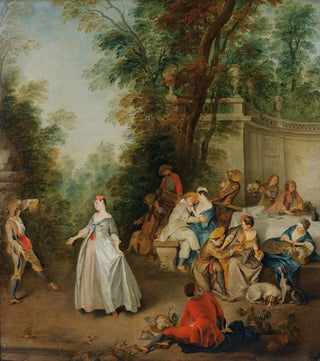Art print | Breakfast in a Park - Nicolas Lancret Workshop


View from behind

Frame (optional)
In the vibrant landscape of 18th-century French art, "L Déjeuner dans un parc - Atelier de Nicolas Lancret" stands out as an iconic work that embodies the lighthearted and refined spirit of the era. This painting, which evokes moments of conviviality and pleasure, transports the viewer into a universe where nature and sociability intertwine harmoniously. The characters, dressed in period costumes, gather around an outdoor feast, symbolizing a time when the art of living was celebrated with éclat. The scene exudes an atmosphere of joy and lightness, inviting contemplation and escape, while revealing the subtleties of aristocratic life of the time.
Style and uniqueness of the work
The work is characterized by a rococo style, rich in details and vibrant colors. The play of light and shadow, skillfully rendered, creates a depth that draws the eye. The characters, with delicate expressions and graceful gestures, are carefully arranged, forming a harmonious composition that guides the viewer across the canvas. Lancret excels in depicting textures, whether it be the fabric of clothing or the surrounding greenery, each element meticulously observed and rendered. The color palette, dominated by tender greens and delicate pinks, contributes to the bucolic atmosphere of the scene. This painting, through its refined aesthetic, aims to pay homage to nature and the joy of living, while highlighting human relationships in an idyllic setting.
The artist and his influence
Nicolas Lancret, a prominent figure of the 18th century, established himself as a master of the fête tableau genre. Raised in the wake of predecessors like Antoine Watteau, he developed a distinctive style that combines finesse and lightness. His ability to capture moments of life, imbued with grace and happiness, grants him a prominent place in art history. Through his works, he explores themes of love, friendship, and pleasure, making each painting an invitation to rêverie. Lancret's influence is evident

Matte finish

View from behind

Frame (optional)
In the vibrant landscape of 18th-century French art, "L Déjeuner dans un parc - Atelier de Nicolas Lancret" stands out as an iconic work that embodies the lighthearted and refined spirit of the era. This painting, which evokes moments of conviviality and pleasure, transports the viewer into a universe where nature and sociability intertwine harmoniously. The characters, dressed in period costumes, gather around an outdoor feast, symbolizing a time when the art of living was celebrated with éclat. The scene exudes an atmosphere of joy and lightness, inviting contemplation and escape, while revealing the subtleties of aristocratic life of the time.
Style and uniqueness of the work
The work is characterized by a rococo style, rich in details and vibrant colors. The play of light and shadow, skillfully rendered, creates a depth that draws the eye. The characters, with delicate expressions and graceful gestures, are carefully arranged, forming a harmonious composition that guides the viewer across the canvas. Lancret excels in depicting textures, whether it be the fabric of clothing or the surrounding greenery, each element meticulously observed and rendered. The color palette, dominated by tender greens and delicate pinks, contributes to the bucolic atmosphere of the scene. This painting, through its refined aesthetic, aims to pay homage to nature and the joy of living, while highlighting human relationships in an idyllic setting.
The artist and his influence
Nicolas Lancret, a prominent figure of the 18th century, established himself as a master of the fête tableau genre. Raised in the wake of predecessors like Antoine Watteau, he developed a distinctive style that combines finesse and lightness. His ability to capture moments of life, imbued with grace and happiness, grants him a prominent place in art history. Through his works, he explores themes of love, friendship, and pleasure, making each painting an invitation to rêverie. Lancret's influence is evident






